Hayden Bulbrook outlines the history of heritage houses (now under threat of demolition) along Stratford, Ontario heritage corridor
A previous post is entitled:
At a more recent post, I’ve shared a letter from Joyce, a long-time Stratford resident, regarding a development proposal regarding the north side of Ontario Street between Queen Street and Trow Avenue.

Aerial view of Ontario Strreet between Trow Avenue (running north-south outside the left edge of the frame) and Queen Street (running north-south outside the right edge of the frame). Cobourg Street runs east-west outside the top of the frame while Ontario Street runs east-west outside the bottom of the frame. Source: September 2021 Stratford Times article by Hayden Bulbrook
As well, I’ve read with interest recent letters to the editor of the Stratford Beacon Herald regarding the Ontario Street proposal:
Letter: Council ignoring its constituents (Oct. 29, 2021)
Letter: Councillors ‘favouring’ Chancery development? (Nov. 2, 2021)
Letter: Heritage or high density? What should Stratford choose? (Nov. 4, 2021)
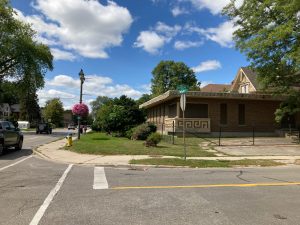
View looking west from the corner of Queen Street (in the foreground) and Ontario Street (on the left) in Stratford. Jaan Pill photo
In previous posts, I’ve highlighted the history of the launch of the Stratford Festival and the redevelopment of the R.M. Ballantyne textile mill property located between the Tom Patterson Theatre and the Festival Theatre.
The current post features an article (I’ve added some paragraph breaks) by Hayden Bulbrook, a cultural heritage specialist at Timmins Martelle Heritage Consultants (THMC) Inc. in London, Ontario.
The article, revised in November 2021, originally appeared in the September 2021 edition of the Stratford Times:
Ontario Street Heritage Face-to-Face with the Wrecking Ball
Long before my time a grand old post office sat in a commanding place at the junction between Ontario Street, Erie Street, and Downie Street. It was demolished in 1961. The demolition of industrial buildings and banks in the name of urban renewal continued into the 1980s and beyond.
City Hall was nearly lost. Last year it was the majestic Italianate building, 91 Brunswick Street, that faced the rise of the machines, its remains carried away in dumpsters.
This trend of demolition continues up to the present with the threat to the Ontario Street Heritage Corridor, the latest that stands face-to-face with the wrecking ball.
Four buildings in a row along the Ontario Street corridor are under threat of demolition for a 3.5+ storey condominium development of significant scale. This development is proposed in a neighbourhood of 1.5 to 2.5 storey single detached houses. These buildings appear to be well-intact. Adaptive reuse and integration into the condominium plan, which the developer has not considered, would be more suitable, appropriate, and environmentally friendly – and would be a marked distinction from a history of demolition in this city.
The developer has stated that the units will be sold at market value and that there will be no affordable housing options, a difficult pill to swallow especially for young Stratfordites trying to break into an increasingly expensive housing market.
It is imperative that we also consider the environmental impact of demolishing heritage buildings. Demolition is inherently tied to waste – waste that amounts to an average of 40 tons added to the landfill when a home is demolished. Most of it is cherished and valuable wood! Is this really what we should strive for as the clear and present danger of climate change is already affecting every one of us?
As an issue that affects Stratford’s heritage, community, and future, I’d like to shine light on the history of these four buildings that are under threat of demolition. The focus is on 370, 388, 390, and 396 Ontario Street.
370 Ontario Street
370 Ontario Street was likely built between 1904 and 1905. It is a solid red brick two-and- a-half-storey structure with a residential form. This Queen Anne style building holds a commanding presence on the corner of Ontario Street and Trow Avenue with its cross- gabling acting as an anchor, opening to this intersection. I would argue that it is also in conversation with two other Queen Anne style homes, 13 and 19 Trow Avenue, both of which are on the east side of this street and have similar cross-gabled layouts. While the latest development plans signal an intention to retain this structure, there are no safeguards in place to ensure demolition will not ultimately occur.
370 Ontario Street has several intact features such as stone sills, lintels, and voussoirs; a brick chimney; a Palladian-window; staggered shingle patterned gables; rich red brick that was likely sourced from local brickyards; and a sympathetic bay window on the west façade.
Beginning in 1905 until 1930, 370 Ontario Street housed George Jeffery, a locomotive engineer with the Grand Trunk Railway (later Canadian National Railway). Jeffery was born on May 17th, 1855, in Kent, England and arrived in Perth County in 1873. He married his wife, Janet Marion Ross, on January 13th, 1886. She was nine years younger than him and was born in Hamilton to Scottish parents, Donald and Elizabeth Ross. George and Janet had two daughters, Mary and Donella.
After a long career in Stratford’s railway industry, George retired in 1923, spending his retirement at 370 Ontario Street alongside Janet until her passing in 1930. George would live for almost two more decades, passing away at the age of 93 in 1948, not quite witnessing Stratford’s economic transition away from the railway industry. By this point he was living at 15 Worsley Street.
388 & 390 Ontario Street
Both houses were likely constructed by businessman and entrepreneur, Arthur H. King, in c. 1894. In other words, 388 and 390 Ontario Street come as a pair and should be regarded as such. 388 and 390 feature full-width shed roof porches with varying wood detailing. A sidelight and a transom light adorn each entry door. 390 features rounded porch columns while the posts on the porch of 388 are squared. Both sit atop red brick piers capped in stone. Roundel windows are located in the peaked gables. Windows are one-over-one. Both buildings feature chamfered corners that oppose each other, demonstrating the mirror pattern of the two.
388 Ontario Street
By 1904, 388 Ontario Street was occupied by Arthur H. King. The eldest of three siblings, King was born in Downie Township on February 9th, 1856, to English-born parents, Henry and Mary King. Arthur worked in a number of industries including employment with the Canada Express Company; as the proprietor of the American House Hotel, which was located on Downie Street; as the manager of the Stratford Soda Water Works Company in 1896; and, at least for a time, as a cigar manufacturer in Stratford’s once modest and seldom-known cigar making industry.
The 1924 city directory noted that he worked in real estate. These roles, as well as investment in local business ventures, suggest that Arthur built these houses for speculative purposes as Stratford’s population grew.
On September 24th, 1879, King and Anna Della Walker of Belleville got married. Walker was born on September 22, 1860. The two had three children, Henry, Beatrice, and Arthur. Young Arthur passed away shortly after birth. Arthur Sr. would live until 1930, passing away at the age of 74, while Anna continued to live at 388 Ontario until her death in 1940.
390 Ontario Street
After a series of short-term occupants, 390 Ontario was occupied by Alex Gillies by 1911. Gillies was born in Glasgow, Scotland on January 29, 1877, to parents Gilbert and Jane Gillies. By 1913, he worked under Norval F. Babb, “a jeweler, optician, and issuer of marriage licenses” at 23 Downie Street. Eleven years later he was operating his own jeweler, watchmaker, and optician business, Gillies & Emm, with partner D.B. Emm at the same location.
Gillies retired on December 14th, 1941, after working in the watchmaking and jewellery business for 38 years – his entire time in Stratford. He passed away January 7, 1942.
Gillies married Mabel E. Lawson, who was of Irish descent, in Goderich on October 28th, 1908. By 1901, Lawson was working as a clerk, though it is unclear where. In 1956, she granted the property to Otto Wessel, a foreman at Fischer Bearings. She passed away in December 1961, her eightieth year.
396 Ontario Street
396 Ontario Street is the oldest building on this block, likely dating from between 1877 and 1882. It may have been constructed by English immigrant Richard Puddicombe who was listed in the 1891 census as a money lender and conveyancer.
The original part of the structure is one-and-a-half storeys tall and is composed of a structural envelope of yellow brick. It reflects the Gothic Revival style, as evidenced in its centre-gable form on the Queen Street elevation, and its decorative finial. Italianate details are represented in the flat window crown, bracketed cornice, and prominent eave returns. These details have survived to the present.
Between 1904 and 1907, furniture magnate George McLagan lived here, likely while his Beaux-Arts mansion at 210 Water Street was being designed and constructed.
McLagan, who was one of Stratford’s most successful industrialists, began his career in the furniture industry when he apprenticed in Stratford. He would relocate to Grand Rapids, Michigan where he continued to learn about the furniture industry and factory production. Returning to Stratford he established McLagan and Porteous with local businessman Robert Porteous.
Porteous retired in 1898 and their original plant on Mill Street (today Douglas Street between Huron Street and St. Vincent Street) burned down March 1st, 1900. A year later McLagan built a four-storey, $35,000 factory at 93 Trinity Street in what would become Stratford’s factory district. For over twenty years he designed all his furniture.
In 1908, his mansion at 210 Water Street was finished and it is at this time that he likely relocated from 396 Ontario Street to his new home. He died on July 5th, 1918, at the age of 56, but the business continued under the McLagan name until sometime between 1937 and 1939, according to city directories.
A strong case could be made for this building’s historical/associative value under Ontario Regulation 9/06 of the Ontario Heritage Act, which outlines criteria for determining cultural heritage value or interest. It should be preserved, restored, and designated under Part IV of the Ontario Heritage Act by Stratford City Council.
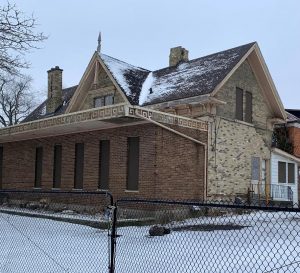
Partial View of Extant Heritage Structure at 396 Ontario Street. Looking southwest.
Hayden Bulbrook, December 2020
Paradigm Shift
Despite the heritage we’ve maintained, Stratford has a long history of demolition. There exists an opportunity to break from this past and adaptively reuse our heritage buildings. Unfortunately, the potential developer of the block composed of 370, 380, 388, and 396 Ontario Street has not considered this.
In an era where a lack of affordable housing and the growing threat of climate change affects all of us, it is time that we realize that preserving heritage is as much about our lives today – and tomorrow – as it is about the stories of yesterday.
Hayden Bulbrook
Cultural Heritage Specialist TMHC Inc., 1108 Dundas Street London, ON
// @StratfordHistory (https://www.instagram.com/stratfordhistory)
// Executive Member, ACO Stratford-Perth County
Revised November 2021


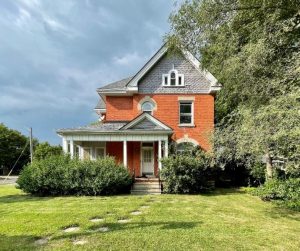
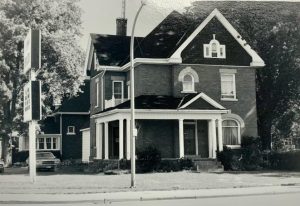
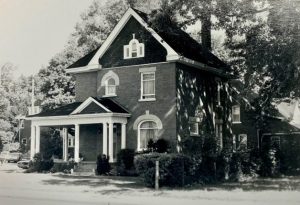
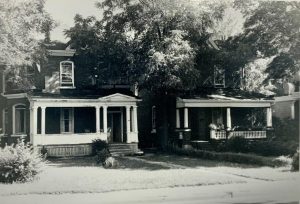
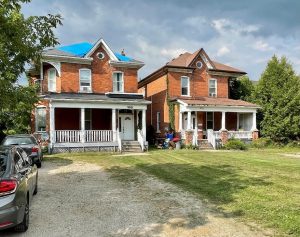
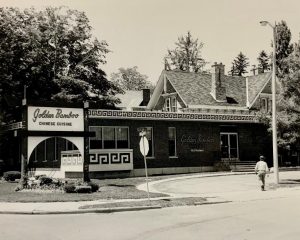
Leave a Reply
Want to join the discussion?Feel free to contribute!